I’ve developed a Peak Sun Hours calculator that lets you determine the Peak Sun Hours for a specific location by simply typing it in, whether it’s a city, a zip code, or an exact address.
While you can use the calculator directly, I recommend checking out this quick tutorial first for the most accurate results.
If you’re interested in learning more, you’ll also find a thorough explanation of what Peak Sun Hours are, and how they can be used to predict solar power output and determine solar panel needs.
Plus, you’ll find additional resources such as Peak Sun Hours Maps, and Peak Sun Hours data by state, and even by zip code.
Peak Sun Hours Calculator
Based on your location and the orientation of your solar panel(s), the following calculator will use historical data provided by NREL (National Renewable Energy Laboratory) to determine how many Peak Sun Hours you can expect to get per day:
Peak Sun Hours Calculator
Data source: NREL (National Renewable Energy Laboratory), as per NREL's terms.
What are Peak Sun Hours?
While the “Hours” in “Peak Sun Hours” might imply that it’s a unit for measuring time, such as the hours between sunrise and sunset or something similar, this is not the case.
Peak Sun Hours are a measurement unit for quantifying the amount of sunlight per unit area accumulated in a certain location, over a certain period, typically a day.
Using more technical terms, Peak Sun Hours can be defined as the amount of sunlight energy (in Wh or kWh) that lands on each square meter (m²) over a defined period. For instance, one Peak Sun Hour means getting 1 kilowatt-hour of energy per square meter (1 kWh/m² or 1,000 Wh/m²).
In the context of solar energy systems, the daily Peak Sun Hours data for a certain location can be used in 2 different ways:
- To predict the daily energy output (kWh) of a solar installation in that location.
- Or to calculate the size of the solar energy system required to meet certain energy production objectives.
For example, according to this data, in May, Tallahassee, FL typically gets about 13 to 14 hours of daylight each day.
However, based on our calculator’s data, on average, Tallahassee only receives 6.56 kilowatt-hours of sunlight energy per square meter per day during May (6.56 kWh/m² per day).
So, we could say that on average throughout May, Tallahassee gets 6.56 Peak Sun Hours per day.
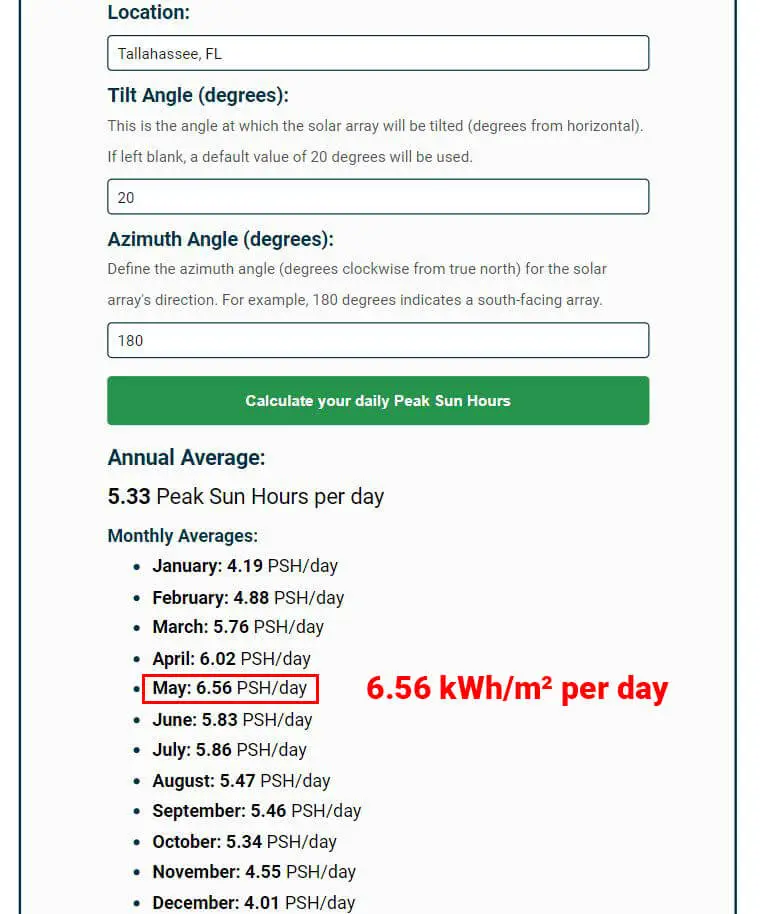
But if you use the calculator for El Paso, Texas, which same as Tallahassee, also gets 13 to 14 daylight hours per day in May, you’ll find that it receives 8.01 Peak Sun Hours per day on average.
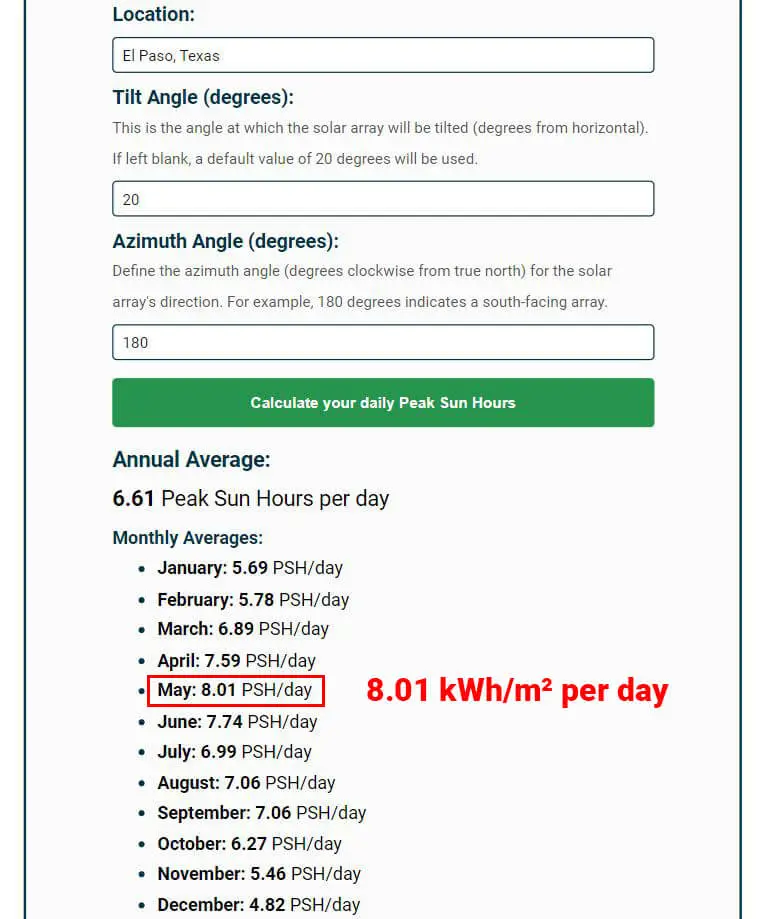
That’s a 22% difference in sunlight energy for the same hours from sunrise to sunset. As I’ll explain here, this 22% difference in Peak Sun Hours will equate to a 22% difference in solar energy production.
In solar energy applications, what truly counts isn’t the hours between sunrise and sunset in a specific location, but rather the total sunlight energy accumulated during those daylight hours, measured in Peak Sun Hours.
However, note that the Peak Sun Hours you receive also depend on factors such as the orientation of your solar panels and shading conditions, not just your location.
While the calculator above retrieves data based on the location, the tilt angle, and the azimuth angle (heading) of your solar panels, it doesn’t account for shading.
Related: Do solar panels work in the shade?
Below is a quick guide on how to properly use our Peak Sun Hours calculator, followed by instructions on how to use that data for your solar energy system calculations.
But if you’re into nerdy solar energy stuff, I recommend reading the next couple of sections beforehand to get a clear understanding of what Peak Sun Hours are once and for all.
Explaining Solar Irradiance:
Solar panels capture sunlight and turn it into usable electricity, known as “electrical power”. The amount of electrical power generated by a solar panel at any given time is typically measured in Watts (W) or kilowatts (kW), where 1 kW equals 1,000 Watts.
Now, solar panels are rated in Watts, indicating the amount of electrical power they can produce. This “Wattage” rating mainly depends on the panel’s physical size.
Essentially, the larger the solar panel, the more surface area it has to capture sunlight, resulting in a higher electrical power output (Watts).
Related: How big is a solar panel?
However, the actual power output of a solar panel at any given moment isn’t just determined by its physical size; it also depends on the intensity of sunlight it receives.
The greater the sunlight intensity a solar panel is exposed to, the more Watts it will produce.
This sunlight intensity is measured in Watts per Square Meter (W/m²) and is known as Solar Irradiance.
The Wattage rating assigned to a solar panel (e.g., 300 Watts) results from testing the panel under specific conditions called Standard Test Conditions (STCs). One of these conditions is a Solar Irradiance of 1,000 Watts per square meter (W/m²), which simulates a clear sunny day with the sun directly overhead.
In simpler terms, a 300-watt solar panel will only generate 300 Watts of power if it’s exposed to 1,000 W/m² of Solar Irradiance.
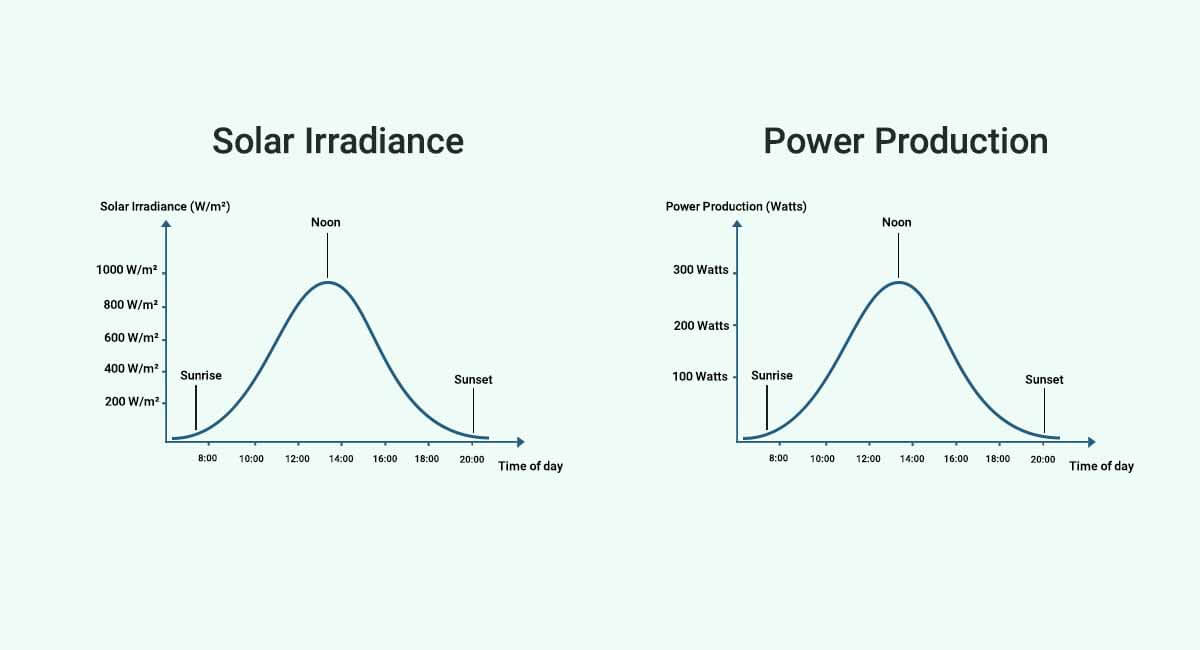
However, in the real world, Solar Irradiance varies throughout the day due to factors like the sun’s position and cloud cover. This variation directly impacts the power output (Watts) of the solar panel at any given moment.
For instance, a 100-watt solar panel might produce 77 Watts right now, but a few seconds later, it could drop to 43 Watts.
Because it’s constantly changing, the power production of a solar panel at a particular moment is really just an indication of the sunlight available at that time and doesn’t have any practical uses for you and me.
When designing a solar energy system or assessing the output of one, we focus on the Electrical Energy (kWh) generated over specific timeframes rather than the Electrical Power (Watts) produced at any given moment.
Related: Energy (kWh) vs Power (Watts)
This leads us to Peak Sun Hours.
Peak Sun Hours VS. Solar Irradiance:
Unlike Solar Irradiance, which only tells us the intensity of sunlight per unit area at a specific moment, Peak Sun Hours measure the total sunlight energy available to solar panels throughout the day.
While Solar Irradiance, measured in Watts per square meter, shows us the instantaneous sunlight intensity received by a square meter (W/m²), 1 Peak Sun Hour equals an energy accumulation of 1 kWh or 1,000 Wh per square meter (1 kWh/m² or 1,000 Wh/m²).
A simplified formula for expressing the relationship between Solar Irradiance and Peak Sun Hours is as follows:
Peak Sun Hours = Solar Irradiance (kW/m²) x Time (Hours)
Let’s consider an example: if sunlight shines with an intensity of exactly 1 kW/m² for a full hour, by the end of that hour, the area would have received 1 kWh/m² of sunlight energy, which equals 1 Peak Sun Hour.
Now, imagine sunlight hitting an area at an intensity of precisely 0.5 kW/m² for 3 consecutive hours. By the end of those 3 hours, the area would have received 1.5 kWh/m² of sunlight energy (0.5 kW/m² x 3 hours), equivalent to 1.5 Peak Sun Hours.
However, these examples are just for illustration purposes to help you understand the relationship between Peak Sun Hours and Solar Irradiance.
In reality, we measure Peak Sun Hours per day (kWh/m²/day), as it’s a more practical way to use this data in solar energy applications.
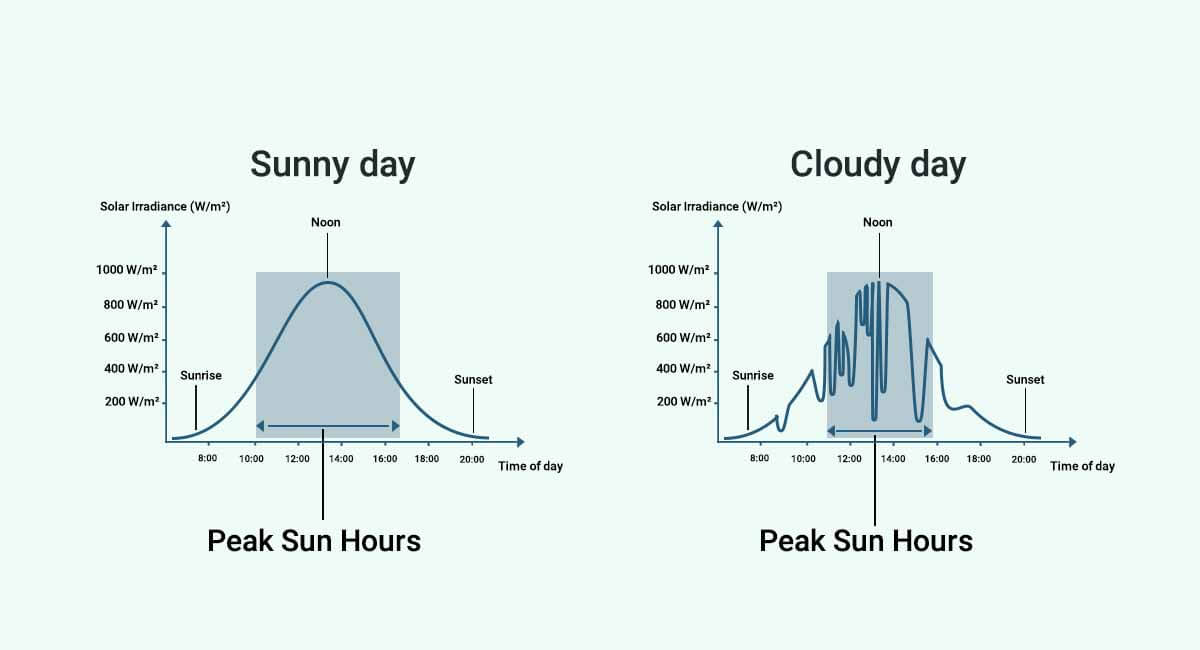
Research facilities collect this data by continuously monitoring Solar Irradiance levels on an hourly or half-hourly basis. They then compile these values into Peak Sun Hours data for each day of the year, allowing them to calculate monthly and yearly averages.
In fact, the values generated by our Peak Sun Hours calculator are derived from data retrieved from The National Solar Radiation Database (NSRDB), which contains 25 years’ worth of meteorological measurements collected by weather stations worldwide.
Because weather conditions tend to follow predictable patterns over months, seasons, and years, historical Peak Sun Hours data from previous years allows us to predict Peak Sun Hours values for future years.
Consequently, historical Peak Sun Hours data for a specific location can be used to predict the energy output of a solar energy system or to design one based on energy production objectives.
Before I explain how this works, let’s first go through the steps to accurately calculate your Peak Sun Hours.
How to calculate your Peak Sun Hours?
Location:
In the first input field, input the location for which you want to retrieve data. This could be your exact address, a zip code, or a city.
You can even enter a state if you want, but if you do, the calculator will automatically fetch data from the weather station nearest to the capital of that state, such as Carson City for Nevada or Helena for Montana.
So, I recommend using your exact address or, at least, a zip code to get data from the closest weather station.
For example, if you live in Reno, NV, with the zip code 89503, simply input that zip code into the address field to get the average Peak Sun Hours for that area.
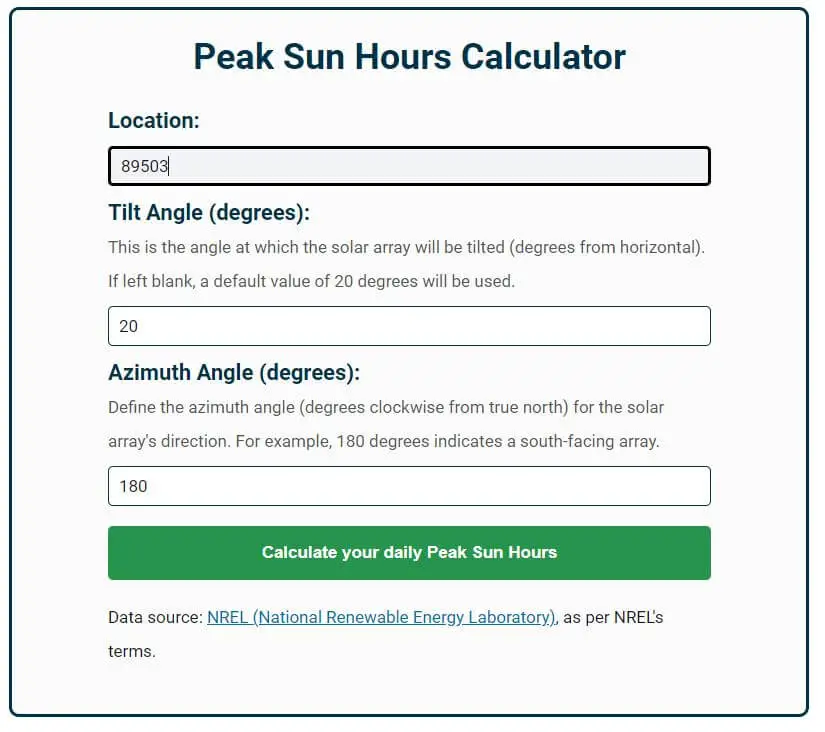
Tilt Angle:
In the second field, input the angle at which your solar panels will be tilted (in degrees from horizontal).
The tilt angle of your solar panels significantly affects the Peak Sun Hours they get, so make sure you enter the correct tilt angle for accurate results.
If your solar panels will be mounted on the roof, enter a tilt angle that matches your roof pitch. For instance, a roof pitch of 5/12 corresponds to a tilt angle of 22.6 degrees:
| Roof Pitch (rise/run) | Tilt Angle (degrees) |
| 4/12 | 18.4 |
| 5/12 | 22.6 |
| 6/12 | 26.6 |
| 7/12 | 30.3 |
| 8/12 | 33.7 |
| 9/12 | 36.9 |
| 10/12 | 39.8 |
| 11/12 | 42.5 |
| 12/12 | 45.0 |
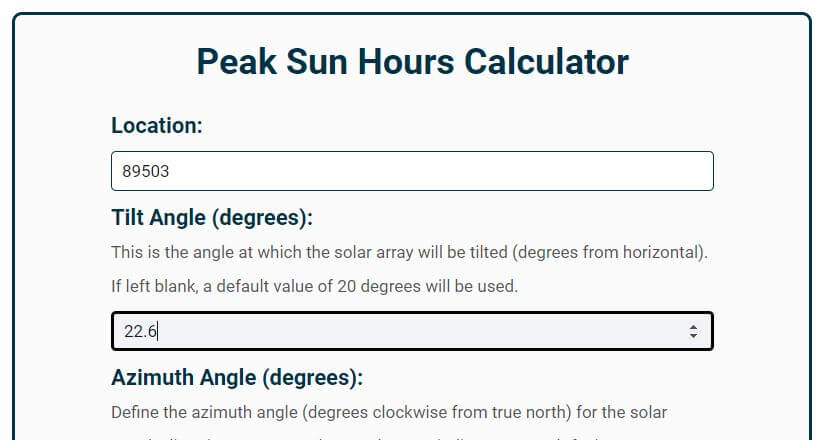
If you’re unsure about the tilt angle of your solar panel(s), you can use an app like Bubble Level, available for both Android and iOS.
If you leave this box empty, the calculator will use a default value of 20 degrees.
Azimuth Angle:
In the third field, enter the Azimuth Angle of your solar panels (degrees clockwise from true north). This is the angle that describes the heading that your solar panels are facing.
For instance, if your solar panels will be installed on a roof section facing Southwest, you should enter 225.
| Heading | Azimuth Angle |
| North | 0° |
| Noth-East | 45° |
| East | 90° |
| South-East | 135° |
| South | 180° |
| South-West | 225° |
| West | 270° |
| North-West | 315° |
Roof-mounted or ground-mounted, a good idea is to use a compass app such as Commander Compass Go for iOS or Azimuth Compass for Android to determine the Azimuth angle as accurately as possible.
Please note that if you leave this input field empty, the calculator will default to using an Azimuth angle of 180 degrees.

Once you’ve filled out these 3 boxes, click the green “Calculate your daily Peak Sun Hours” to retrieve the data.
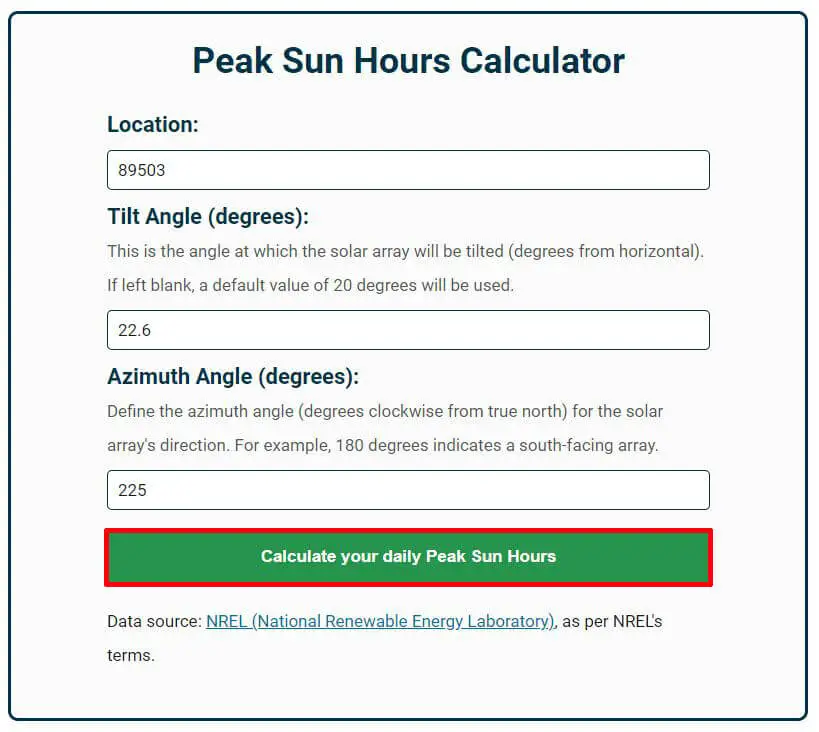
As you can see here, the calculator displays annual and monthly averages of the daily Peak Sun Hours for the selected location.
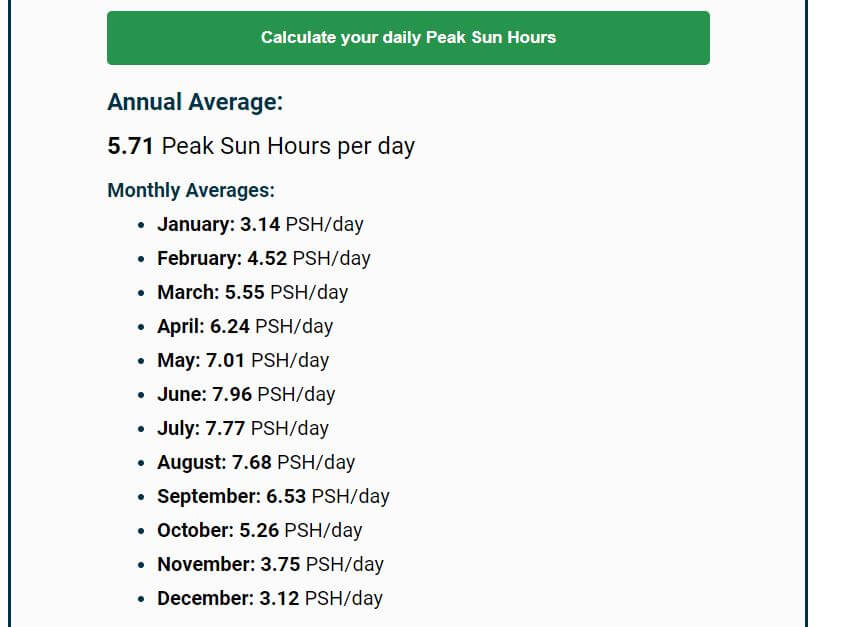
If you’re still thinking about how to set up your solar panels and you have flexibility regarding their orientation, you can adjust the Tilt and Azimuth angles to get the most Peak Sun Hours and fit your needs.
For example, let’s say I’m planning a DIY solar project and I need the most sunlight in winter. Since the sun is closer to the horizon in the winter, I would have to set up the solar panels at a steeper angle to get as much sunlight as possible.
Related: How to increase solar panel output?
Either way, once you know your Peak Sun Hours, you can use those values to determine your solar energy potential or to size the solar system that you need.
Let me explain how.
Peak Sun Hours and Solar Energy
Given the power rating of a solar energy system (measured in Watts or kilowatts) and historical Peak Sun Hours data for a specific location, you can predict the energy production of the system using the following formula:
Daily Energy Production (Watt-hours or kiloWatt-hours) = Power Rating (Watts or kiloWatts) x Daily Peak Sun Hours
For instance, let’s say we want to estimate the daily energy production of a 200-watt solar panel in Austin, TX.
According to our Peak Sun Hours calculator, here are the Peak Sun Hours values for the city of Austin:
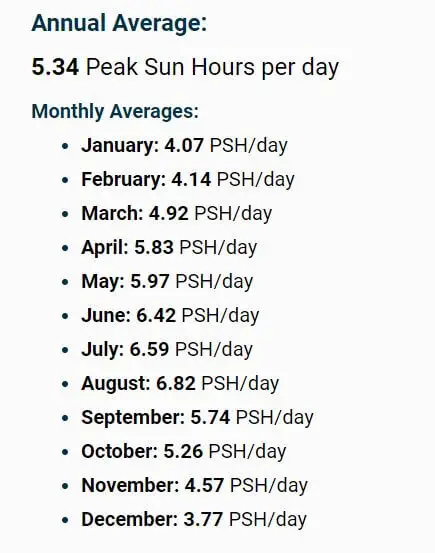
The calculator predicts that throughout the year, south-facing solar panels tilted at a 20-degree angle in Austin would receive an average of 5.34 Peak Sun Hours per day.
The average daily energy production of a 200W solar panel with the same orientation in Austin can be calculated as follows:
Daily Energy Production (Watt-hours or kiloWatt-hours) = Power Rating (Watts or kiloWatts) x Daily Peak Sun Hours
Daily Energy Production (Watt-hours) = 200 Watts x 5.34 Peak Sun Hours
Daily Energy Production (Watt-hours) = 1268 Watt-hours
Daily Energy Production (kiloWatt-hours) = 1.26 kiloWatt-hours
Please note that this is the “Annual Average”.
Because sunlight is more abundant in the summer than in the winter, daily Peak Sun Hours values will naturally vary throughout the year, which will reflect on the daily energy production of the solar panel.
For example, if you look at the “Monthly Averages” above, you’ll notice that this location receives up to 6.82 Peak Sun Hours per day in August, but only receives 3.77 Peak Sun Hours per day in December.
These “Monthly Averages” can be very useful if we’re looking to predict the energy production output for a specific month.
Conversely, Peak Sun Hours allow us to calculate the size of the solar energy system that we need based on our energy needs:
Power Rating (Watts or kiloWatts) = Daily Energy Needs (Watt-hours or kiloWatt-hours) ÷ Daily Peak Sun Hours
For example, let’s say we want a solar energy system that can produce 10 kWh (10,000 Wh) of energy per day, using the same Austin example.
The size or Wattage rating of our solar array can be calculated as follows:
Power Rating (Watts or kiloWatts) = Daily Energy Needs (Watt-hours or kiloWatt-hours) ÷ Daily Peak Sun Hours
Power Rating (kiloWatts) = 10 kiloWatt-hours ÷ 5.34 Peak Sun Hours
Power Rating (kiloWatts) = 1.87 kW
Power Rating (Watts) = 1,870 W
Now, this system size was calculated using the “Annual Average” value.
This means that while the energy production of the system will average out to 10 kWh per day over a year, it will exceed 10 kWh/day in the summer but will not reach it in the winter.
In a grid-tied installation scenario, especially one with net metering or a similar arrangement, this shouldn’t be an issue.
However, with an off-grid solar energy system, where we need the system to produce at least 10 kWh of energy per day, we would need to consider the worst-case scenario.
In other words, we should use the lowest Peak Sun Hours value provided by the calculator to ensure that the system is large enough to meet our daily energy needs.
For instance, if we use the Peak Sun Hours from December, the Wattage rating of our off-grid system would have to be:
Power Rating (Watts or kiloWatts) = Daily Energy Needs (Watt-hours or kiloWatt-hours) ÷ Daily Peak Sun Hours
Power Rating (kiloWatts) = 10 kiloWatt-hours ÷ 3.77 Peak Sun Hours
Power Rating (kiloWatts) = 2.65 kW
Power Rating (Watts) = 2,650 W
In either scenario, the system would need to be about 20 to 30% larger to account for system losses resulting from factors such as soiling, high temperatures, and the inefficiencies of system components and wiring.
Peak Sun Hours Map
Here’s the Peak Sun Hours map for the United States:
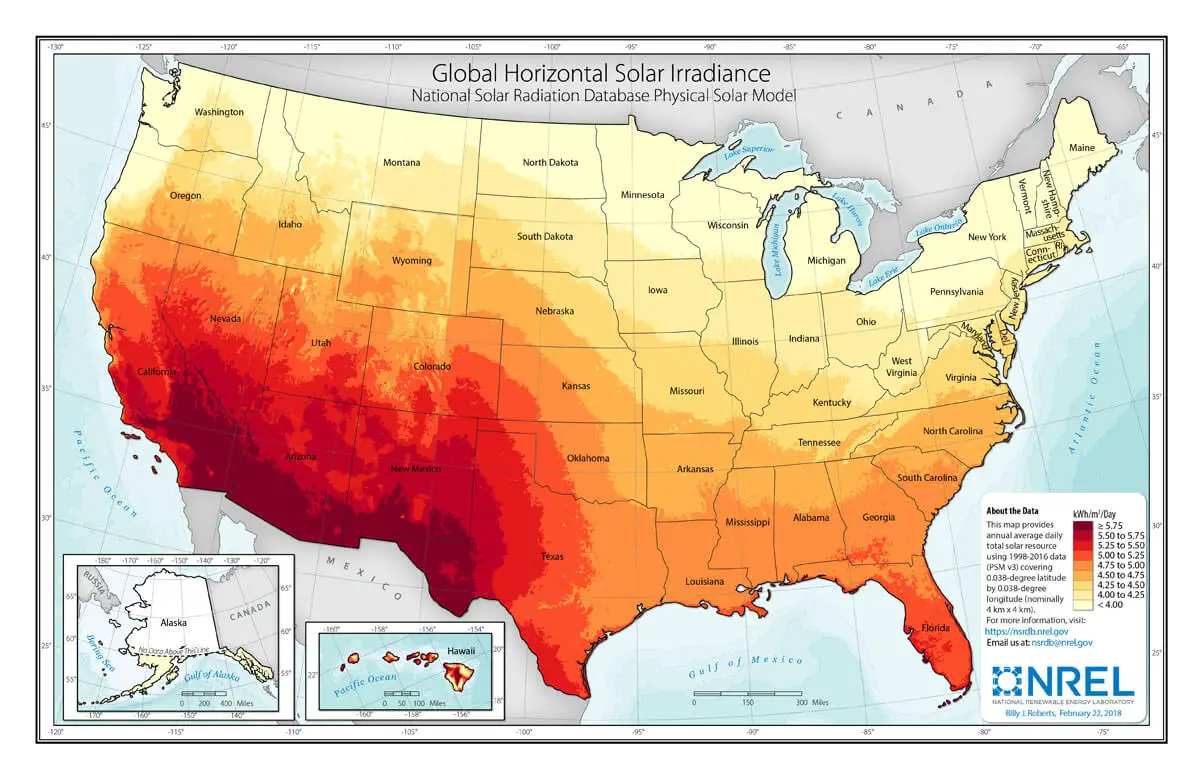
The regions shaded in the darkest red indicate the highest annual average daily Peak Sun Hours (kWh/m²/day). Click here for full resolution.
For instance, you’ll notice that the Southwest region, covering parts of states like California, Arizona, New Mexico, and Texas, receives an annual average of 5.75 Peak Sun Hours or more per day (5.75 kWh/m²/day).
In contrast, the Northeast region with states like Maine, New Hampshire, Vermont, and New York, receives an annual average of less than 4 Peak Sun Hours per day (4 kWh/m²/day).
For comparison, here’s the global Peak Sun Hours map:
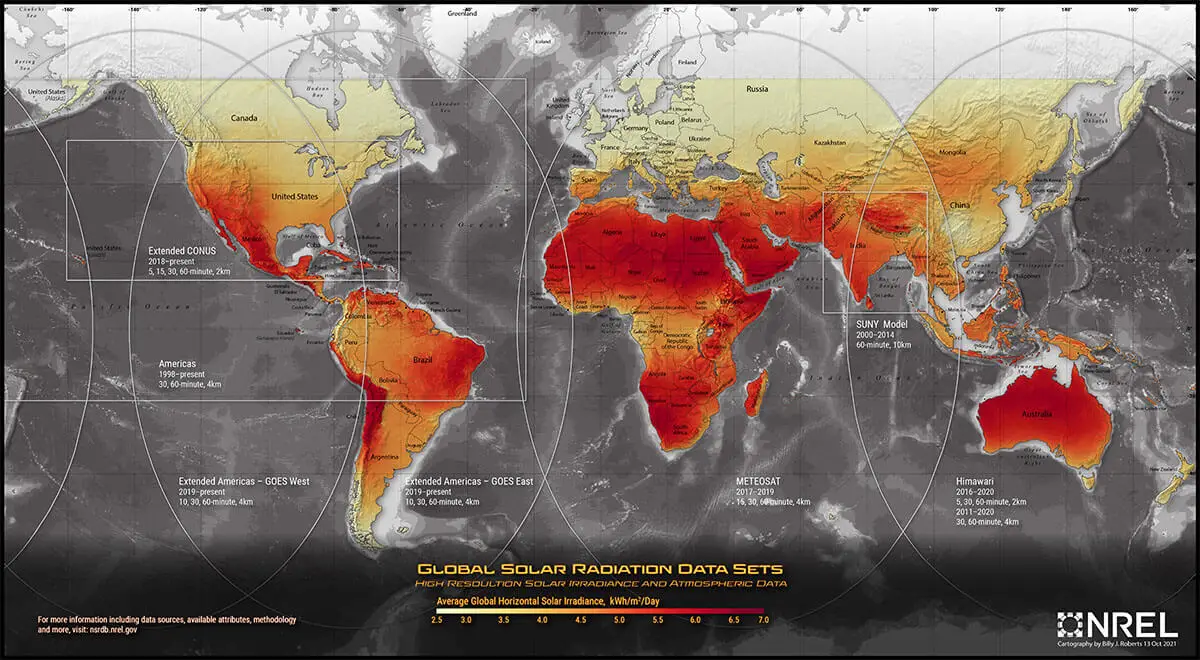
Click here for full resolution.
Please note that both of these maps show Peak Sun Hours data for a tilt angle of 0 degrees (parallel to the ground). At this tilt angle, Peak Sun Hours are referred to as Global Horizontal Solar Irradiance (GHI).
If you’d like to look at more of this visual data for different locations around the world, you can do that using NSRDB’s Data Viewer.
Now, let’s look at some stats specific to the U.S.
Peak Sun Hours by State
The table below provides the annual average daily Peak Sun Hours by state. These estimates are based on a tilt angle of 20 degrees from horizontal and an Azimuth angle of 180 degrees (clockwise from true north):
| State | Average Daily Peak Sun Hours |
| Alabama | 5 – 5.4 |
| Alaska | 2.2 – 3.3 |
| Arizona | 6.4 – 6.7 |
| Arkansas | 5 – 5.2 |
| California | 5.5 – 6.2 |
| Colorado | 5.3 – 5.7 |
| Connecticut | 4.5 – 4.7 |
| Delaware | 4.7 – 4.9 |
| Florida | 5.4 – 5.8 |
| Georgia | 5.1 – 5.3 |
| Hawaii | 4.7 – 6.1 |
| Idaho | 5 – 5.4 |
| Illinois | 4.5 – 4.8 |
| Indiana | 4.5 – 4.9 |
| Iowa | 4.6 – 4.8 |
| Kansas | 5 – 5.7 |
| Kentucky | 4.5 – 4.9 |
| Louisiana | 5.1 – 5.3 |
| Maine | 4.2 – 4.6 |
| Maryland | 4.6 – 4.9 |
| Massachusetts | 4.5 – 4.7 |
| Michigan | 4.2 – 4.5 |
| Minnesota | 4.3 – 4.6 |
| Mississippi | 5.1 – 5.4 |
| Missouri | 4.8 – 5 |
| Montana | 4.2 – 4.7 |
| Nebraska | 4.8 – 5.4 |
| Nevada | 5.3 – 6.4 |
| New Hampshire | 4.3 – 4.7 |
| New Jersey | 4.6 – 4.9 |
| New Mexico | 6.2 – 6.6 |
| New York | 4.2 – 4.5 |
| North Carolina | 5 – 5.2 |
| North Dakota | 4.4 – 4.8 |
| Ohio | 4.3 – 4.7 |
| Oklahoma | 5.1 – 6.1 |
| Oregon | 4 – 5.1 |
| Pennsylvania | 4.3 – 4.8 |
| Rhode Island | 4.6 – 4.7 |
| South Carolina | 5.2 – 5.4 |
| South Dakota | 4.6 – 5.3 |
| Tennessee | 4.8 – 5.2 |
| Texas | 5.2 – 6.6 |
| Utah | 5.1 – 6.3 |
| Vermont | 4.1 – 4.6 |
| Virginia | 4.8 – 5.1 |
| Washington | 3.8 – 4.9 |
| West Virginia | 4.3 – 4.7 |
| Wisconsin | 4.3 – 4.6 |
| Wyoming | 4.9 – 5.3 |
The ranges provided in the table were determined by looking at the annual average daily Peak Sun Hours in 5 to 10 cities in each of these states.
For example, you can see that Alaska gets between 2.2 and 3.3 PSH/day on average. 2.2 PSH/day is the annual average for the city of Barrow (Utqiagvik), and 3.3 PSH/day is the average for the city of Anchorage.
Or, in the case of Mississippi, 5.1 PSH/day is the average for the city of Southaven, and 5.4 PSH/day is the average for the city of Gulfport.
As you can see from the data, northeastern states like Maine, Vermont, New York, and Michigan receive the fewest Peak Sun Hours, while southwestern states such as New Mexico, Arizona, Nevada, and California get the most.
However, it’s important to note that Peak Sun Hours can still vary significantly within states like Alaska, California, Texas, Nevada, Oklahoma, Oregon, and Utah due to differences in latitudes, elevations, and climates.
For example, while Houston, TX averages 5.18 PSH/day throughout the year, El Paso, TX receives 6.61 PSH/day on average.
So, even though both cities are in the same state, you would need approximately 27% more solar power in Houston compared to El Paso to generate the same amount of energy throughout the year.
Another thing to note (again), is that, while the table provides annual averages, if you’re planning an off-grid system, your focus should be more on Monthly averages instead, since the Peak Sun Hours that a location receives can vary greatly throughout the year.
For example, let’s look at the Peak Sun Hours data for the cities of Sacramento, CA, and San Diego, CA:
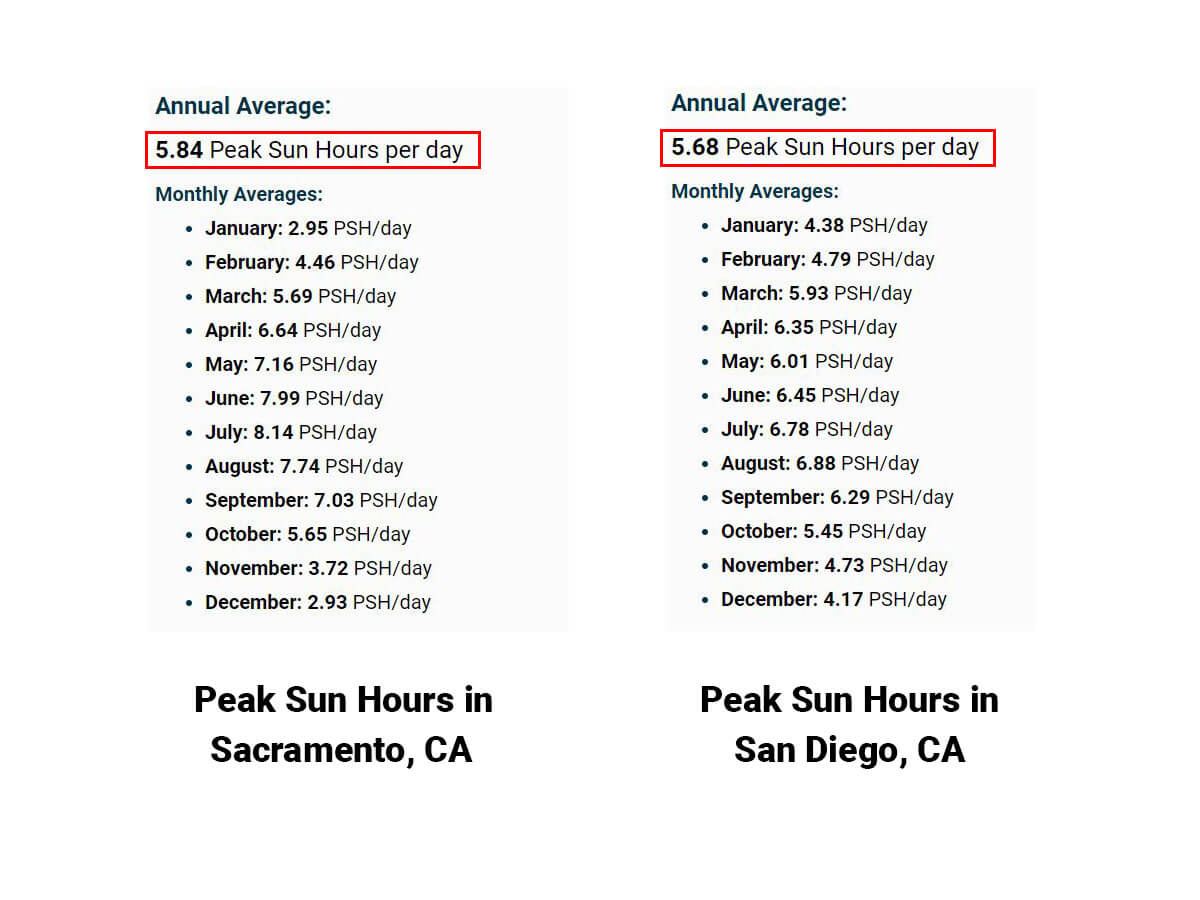
At first glance, it might look like less solar power would be needed in Sacramento since it receives more Peak Sun Hours per day on average. This might be true for grid-tied solar installations with net metering, but not for off-grid installations.
If you look at the lowest monthly averages for each location, you can see that while San Diego gets 4.17 Peak Sun Hours per day in December, Sacramento only gets 2.93 PSH/day.
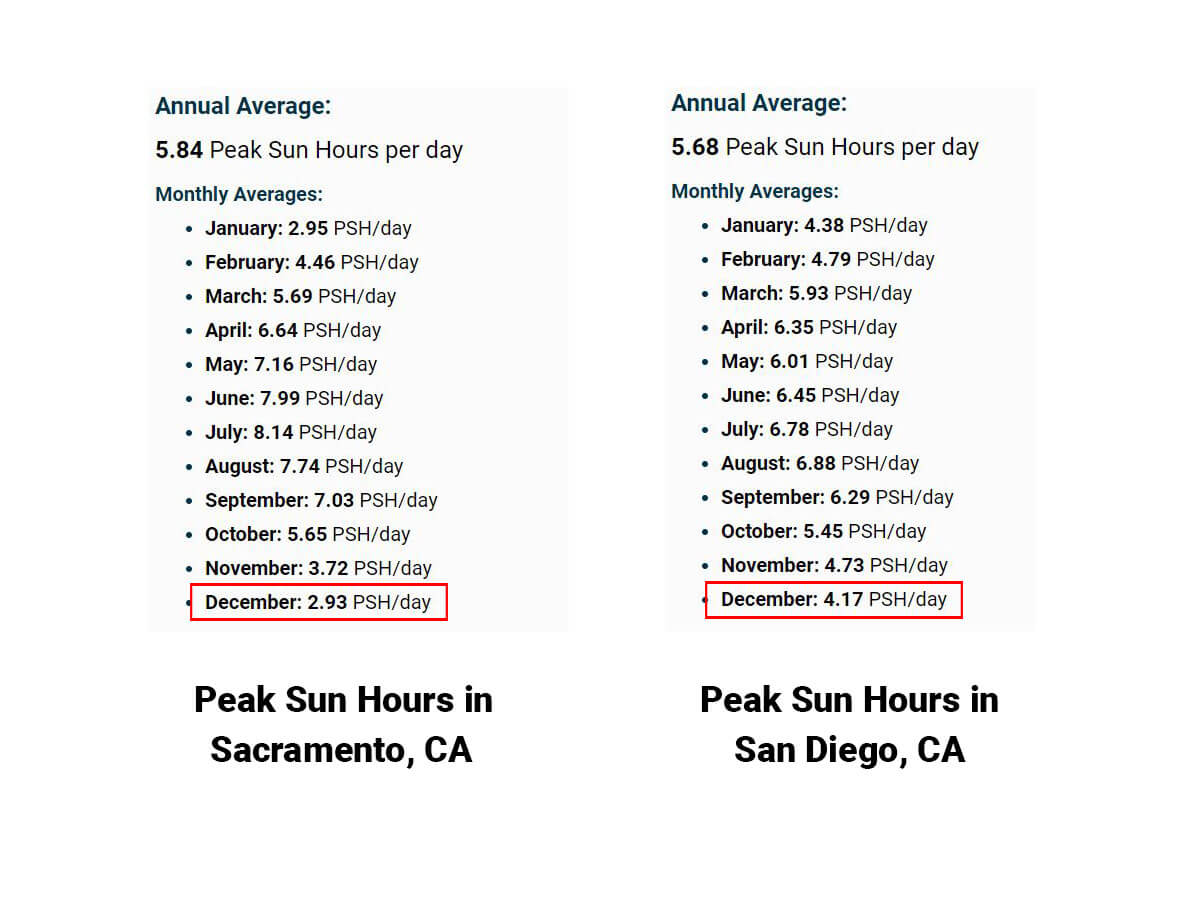
This means that an off-grid solar energy system would have to be about 40% larger in Sacramento to account for the low Peak Sun Hours received in December.
Here’s some more specific data you might find interesting.
Peak Sun Hours by zip code
The table below lists the daily Peak Sun Hours by zip code for the top 100 most populated zip codes in the U.S.
It includes the annual average as well as the lowest and highest monthly average daily Peak Sun Hours (kWh/m²/day) for these locations. These values were calculated assuming a tilt angle of 20 degrees and an Azimuth angle of 180 degrees (South-facing).
| ZipCode | City | Annual Average (PSH/day) | Highest Monthly Average (PSH/day) | Lowest Monthly Average (PSH/day) |
| 87121 | Albuquerque NM | 6.39 | 8.03 (Jun.) | 4.43 (Dec.) |
| 92804 | Anaheim CA | 6.01 | 7.46 (Jul./ Aug.) | 4.17 (Dec.) |
| 37013 | Antioch TN | 4.92 | 6.57 (Jun.) | 2.83 (Dec.) |
| 30349 | Atlanta GA | 5.17 | 6.49 (May) | 3.76 (Jan.) |
| 93307 | Bakersfield CA | 6.18 | 8.16 (Jun.) | 3.35 (Jan) |
| 91706 | Baldwin Park CA | 5.96 | 7.66 (Aug.) | 3.96 (Dec.) |
| 90201 | Bell Gardens CA | 6.04 | 7.57 (Aug.) | 4.02 (Dec.) |
| 90706 | Bellflower CA | 5.95 | 7.54 (Aug.) | 3.96 (Dec.) |
| 10467 | Bronx NY | 4.67 | 6.38 (Jul.) | 2.35 (Dec.) |
| 10456 | Bronx NY | 4.62 | 6.31 (Jul.) | 2.63 (Dec.) |
| 10453 | Bronx NY | 4.63 | 6.29 (Jul.) | 2.69 (Dec.) |
| 10458 | Bronx NY | 4.63 | 6.29 (Jul.) | 2.69 (Dec.) |
| 10452 | Bronx NY | 4.62 | 6.27 (Jul.) | 2.67 (Dec.) |
| 10468 | Bronx NY | 4.63 | 6.29 (Jul.) | 2.69 (Dec.) |
| 10462 | Bronx NY | 4.66 | 6.38 (Jul.) | 2.54 (Dec.) |
| 11226 | Brooklyn NY | 4.77 | 6.5 (Jul.) | 2.68 (Dec.) |
| 11230 | Brooklyn NY | 4.85 | 6.38 (Jul.) | 2.32 (Dec.) |
| 11206 | Brooklyn NY | 4.57 | 6.41 (Jul.) | 2.63 (Dec.) |
| 11212 | Brooklyn NY | 4.59 | 6.41 (Jul.) | 2.63 (Dec.) |
| 11214 | Brooklyn NY | 4.68 | 6.48 (Jul.) | 2.63 (Dec.) |
| 11219 | Brooklyn NY | 4.77 | 6.5 (Jul.) | 2.68 (Dec.) |
| 11207 | Brooklyn NY | 4.59 | 6.41 (Jul.) | 2.63 (Dec.) |
| 11234 | Brooklyn NY | 4.62 | 6.35 (Jul.) | 2.31 (Dec.) |
| 11235 | Brooklyn NY | 4.57 | 6.34 (Jul.) | 2.48 (Dec.) |
| 78521 | Brownsville TX | 5.53 | 6.59 (Jul.) | 4.01 (Jan.) |
| 28269 | Charlotte NC | 5.25 | 6.54 (Jul.) | 3.41 (Dec.) |
| 60629 | Chicago IL | 4.63 | 6.82 (Jul.) | 2.05 (Dec.) |
| 60618 | Chicago IL | 4.49 | 6.3 (Jul.) | 2.02 (Dec.) |
| 60617 | Chicago IL | 4.54 | 6.51 (Jul.) | 2.22 (Dec.) |
| 60647 | Chicago IL | 4.52 | 6.6 (Jul.) | 2.22 (Dec./Jan.) |
| 60625 | Chicago IL | 4.49 | 6.3 (Jul.) | 2.02 (Dec.) |
| 91710 | Chino CA | 6.08 | 7.71 (Jul.) | 4.18 (Dec.) |
| 91709 | Chino Hills CA | 6.13 | 7.83 (Jul.) | 4.19 (Dec.) |
| 91911 | Chula Vista CA | 6.19 | 7.38 (Aug.) | 4.49 (Dec.) |
| 91910 | Chula Vista CA | 6.08 | 7.13 (Jul.) | 4.73 (Dec./Jan.) |
| 11368 | Corona NY | 4.65 | 6.35 (Jun.) | 2.26 (Dec.) |
| 77429 | Cypress TX | 5.22 | 6.26 (Jun.) | 3.75 (Jan.) |
| 75217 | Dallas TX | 5.4 | 7 (Jul.) | 3.94 (Dec.) |
| 75211 | Dallas TX | 5.4 | 6.93 (Jul.) | 3.8 (Dec.) |
| 79936 | El Paso TX | 6.76 | 8.09 (May) | 5.24 (Dec.) |
| 79912 | El Paso TX | 6.64 | 7.94 (May) | 4.89 (Dec.) |
| 11373 | Elmhurst NY | 4.65 | 6.38 (Jul.) | 2.48 (Dec.) |
| 11355 | Flushing NY | 4.59 | 6.33 (Jul.) | 2.47 (Dec.) |
| 92335 | Fontana CA | 6.18 | 7.82 (Jul.) | 4.15 (Dec.) |
| 92336 | Fontana CA | 6.12 | 7.78 (Jul.) | 4.13 (Dec.) |
| 93722 | Fresno CA | 6.06 | 8.18 (Jun.) | 3.07 (Dec.) |
| 75052 | Grand Prairie TX | 5.46 | 6.91 (Jul.) | 3.45 (Dec.) |
| 90250 | Hawthorne CA | 6.01 | 7.4 (Jul.) | 4.09 (Dec.) |
| 94544 | Hayward CA | 5.69 | 7.75 (Jul.) | 3.29 (Jan.) |
| 92345 | Hesperia CA | 6.78 | 8.29 (Jun.) | 4.53 (Dec.) |
| 77084 | Houston TX | 5.25 | 6.34 (Jul.) | 3.8 (Jan.) |
| 77036 | Houston TX | 5.19 | 6.25 (Jun.) | 3.55 (Dec.) |
| 77083 | Houston TX | 5.22 | 6.41 (Jul.) | 3.49 (Dec.) |
| 90255 | Huntington Park CA | 6.03 | 7.42 (Jul.) | 4.02 (Dec.) |
| 77449 | Katy TX | 5.26 | 6.53 (Jul.) | 3.8 (Jan.) |
| 77494 | Katy TX | 5.37 | 6.53 (Aug.) | 3.42 (Dec.) |
| 91744 | La Puente CA | 6 | 7.6 (Jul.) | 3.84 (Dec.) |
| 08701 | Lakewood NJ | 4.76 | 6.19 (Jul.) | 2.69 (Dec.) |
| 93535 | Lancaster CA | 6.62 | 8.14 (Jun.) | 4.33 (Dec.) |
| 89110 | Las Vegas NV | 6.32 | 8.32 (Jun.) | 3.7 (Dec.) |
| 30044 | Lawrenceville GA | 5.03 | 6.26 (May) | 3.17 (Dec) |
| 30043 | Lawrenceville GA | 5.17 | 6.7 (Jun.) | 3.5 (Dec.) |
| 77573 | League City TX | 5.15 | 6.32 (Aug.) | 3.48 (Dec.) |
| 90805 | Long Beach CA | 6.01 | 7.43 (Jul.) | 4.08 (Dec.) |
| 90011 | Los Angeles CA | 6.04 | 7.49 (Aug.) | 4.03 (Dec.) |
| 90044 | Los Angeles CA | 6.09 | 7.55 (Aug.) | 4.19 (Dec.) |
| 75070 | McKinney TX | 5.52 | 6.81 (Aug.) | 3.97 (Dec.) |
| 78572 | Mission TX | 5.83 | 6.89 (Aug.) | 4.28 (Dec.) |
| 92553 | Moreno Valley CA | 6.29 | 7.85 (Jun.) | 4.29 (Dec.) |
| 37211 | Nashville TN | 4.91 | 6.53 (Jun.) | 2.97 (Jan.) |
| 10025 | New York NY | 4.64 | 6.36 (Jul.) | 2.52 (Dec.) |
| 10002 | New York NY | 4.63 | 6.34 (Jul.) | 2.54 (Dec.) |
| 10029 | New York NY | 4.68 | 6.32 (Jul.) | 2.5 (Dec.) |
| 90650 | Norwalk CA | 5.99 | 7.46 (Jul.) | 3.86 (Dec.) |
| 66062 | Olathe KS | 5.03 | 6.71 (Jul.) | 2.88 (Dec.) |
| 93033 | Oxnard CA | 5.98 | 7.33 (Aug.) | 4.42 (Jan.) |
| 91331 | Pacoima CA | 6.28 | 7.83 (Jul.) | 4.4 (Jan.) |
| 93550 | Palmdale CA | 6.65 | 8.15 (Jun.) | 4.29 (Dec.) |
| 77584 | Pearland TX | 5.19 | 6.31 (Jun.) | 3.65 (Dec.) |
| 78577 | Pharr TX | 5.62 | 6.61 (Jul.) | 4.17 (Jan.) |
| 94565 | Pittsburg CA | 5.94 | 8.31 (Jul.) | 3.11 (Dec.) |
| 93257 | Porterville CA | 6.04 | 8.03 (Jun.) | 3.53 (Jan.) |
| 91335 | Reseda CA | 6.12 | 7.72 (Aug.) | 4.08 (Dec.) |
| 92376 | Rialto CA | 6.21 | 7.85 (Jun.) | 4.14 (Dec.) |
| 92503 | Riverside CA | 6.27 | 7.86 (Jun.) | 4.21 (Dec.) |
| 92509 | Riverside CA | 6.17 | 7.77 (Jul.) | 4.18 (Dec.) |
| 95823 | Sacramento CA | 5.77 | 8.27 (Jul.) | 2.56 (Dec.) |
| 92154 | San Diego CA | 6.16 | 7.37 (Jun.) | 4.43 (Dec.) |
| 00926 | San Juan PR | 5.46 | 5.97 (Mar.) | 4.93 (Nov.) |
| 92704 | Santa Ana CA | 6.01 | 7.42 (Aug.) | 4.05 (Dec.) |
| 93065 | Simi Valley CA | 6.18 | 7.72 (Aug.) | 4.07 (Dec.) |
| 90280 | South Gate CA | 6.03 | 7.42 (Jul.) | 4.02 (Dec.) |
| 77479 | Sugar Land TX | 5.24 | 6.29 (Aug.) | 3.6 (Dec.) |
| 91342 | Sylmar CA | 6.34 | 7.96 (Jul./Aug.) | 4.23 (Dec.) |
| 23464 | Virginia Beach VA | 4.97 | 6.29 (Jun.) | 3.04 (Dec.) |
| 95076 | Watsonville CA | 5.52 | 7.06 (Jun.) | 3.47 (Jan.) |
| 92683 | Westminster CA | 6.02 | 7.43 (Jul./Aug.) | 3.93 (Dec.) |
| 22193 | Woodbridge VA | 4.88 | 6.32 (Jun.) | 2.93 (Dec.) |
| 11377 | Woodside NY | 4.65 | 6.38 (Jul.) | 2.48 (Dec.) |
| 85364 | Yuma AZ | 6.65 | 7.98 (Jun.) | 4.59 (Dec.) |
As you can see, the amount of sunlight received by these locations usually peaks in May, June, July, or August, while it tends to be at its lowest in December.
For example, among all these zip codes, “60618” in Chicago, IL, with an annual average of 4.49 Peak Sun Hours per day, experiences the lowest monthly average Peak Sun Hours throughout the year: 2.02 PSH/day on average in December.
On the other hand, “89110” in Las Vegas, NV, with an annual average of 6.32 Peak Sun Hours per day, boasts the highest monthly average Peak Sun Hours throughout the year: 8.32 PSH/day on average in June.
I used the Peak Sun Hours calculator above to gather data for each of these zip codes. So if your zip code isn’t listed in the table, you can look it up on the calculator yourself.
However, remember that I used a Tilt angle of 20 degrees and an Azimuth angle of 180 degrees. Make sure you enter the appropriate angles that describe your system for accurate results.

